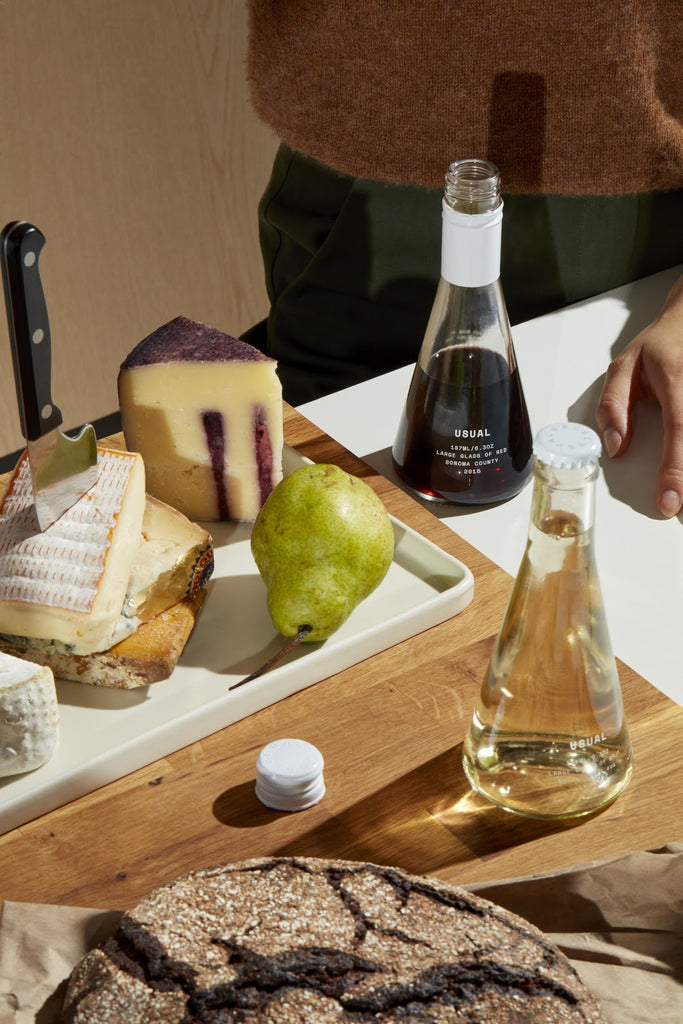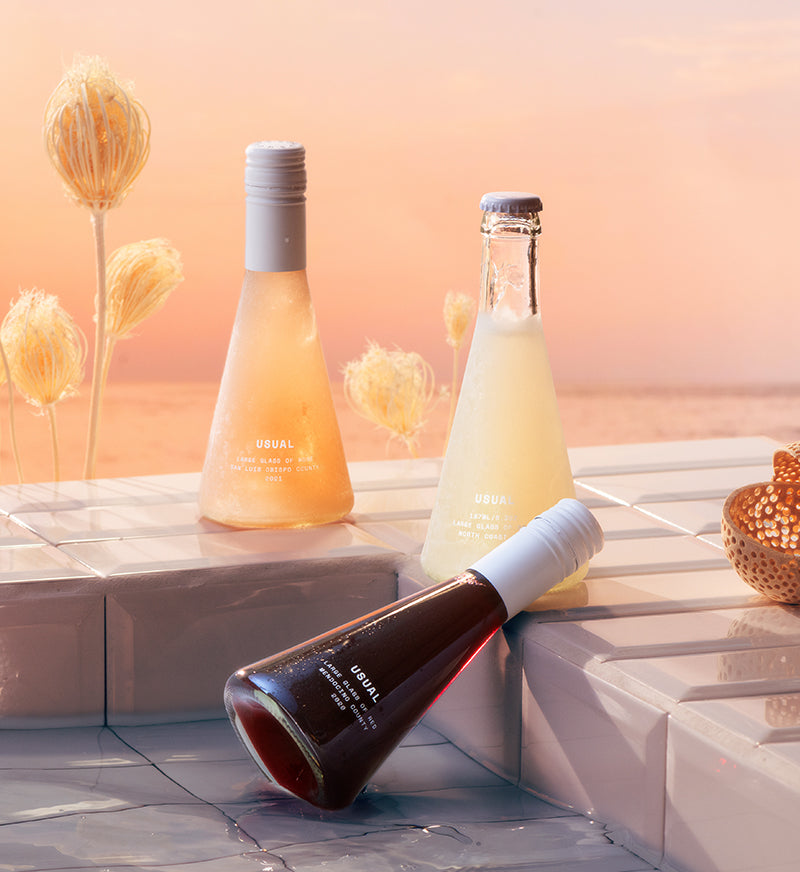Your cart looks a little empty!
Continue Shopping
Wine and Cheese Pairings: Exploring the Art of Cheese and Wine Pairing
McKenzie Hagan |
When it comes to wine pairing, the best way to discover what works is to experiment and let your taste buds take the lead. That said, it helps to have a little direction. To help you on your way, here are some basic guidelines for creating the perfect cheese and wine pairings.
Why Does Wine and Cheese Pairing Work?
Winemaking and cheesemaking have flourished side-by-side for centuries, so it’s no surprise that this food and drink combination go so well together. Both often take years of aging to reach maturation and optimum flavor, both require careful tending by artisan producers, and both are often created in similar terroir.
Still, you could say that wine and cheese have a yin and yang kind of relationship going on. Cheese is fatty. Wine is sharp. Yet these opposites attract to create a magical coupling of flavor and texture. And it seems that scientists have discovered why these two are better together.
A Perfect Balance
In a study conducted at ChemoSens in France, researchers determined that cheese improved the perception of fruit aromas, reduced the duration of astringency of red wines, and heightened the taste of white wine.
As it turns out, cheese — which is customarily high in fat — coats the mouth and blocks taste receptors to beverages. The acidity and sweetness of a well-paired wine cut through this creamy barrier to unlock a fuller flavor on the palate and create an excellent mouthfeel.
Top Tips for Pairing Wine and Cheese

Now that you know why wine and cheese make such a fantastic pair, it’s time to brush up on some of the finer points of putting them together. Here are some must-have tips for pairing wine and cheese.
- Beware of tannins. Tannins are natural compounds in plants that create a bitter taste or drying sensation on the tongue. They’re why over-brewed tea and high-tannin red wines make your mouth feel drier and rougher after a sip. Scientists hypothesize that grapes have tannins in the skin and seeds as an evolutionary trick to prevent wild animals from eating them. Tannins in red wines cause the worst clashes when it comes to cheese, so pair with caution.
- Heavy with heavy, light with light. When it comes to texture and flavor, the idea of “like goes with like” can be a good rule of thumb. Aged cheddar works well with full-bodied white wines like Chardonnay and tannic red wines. On the other hand, fresh, delicate cheeses pair well with younger, fruitier wines.
- Opposites attract. Chocolate and chili, lime and black pepper. These are just a couple of examples where opposite tastes seem made for one another. A tangy Sauvignon Blanc matches perfectly with buttery fresh cheeses, as does the luscious pairing between a sweet Moscato wine and a salty Stilton or Italian Parmesan.
- Things that grow together go together. The concept of terroir describes the environment (including soil and climate) in which wines grow. The same idea can be applied to cheese. As such, it can be fun (and educational) to match wine and cheese from the same area. Brunello and Pecorino di Pienza from Tuscany or Sancerre and chèvre from France are two beloved pairings based on terroir.
How to Pick the Right Cheeses to Suit Your Wine
Preparing the perfect cheese board for your wine can be a challenge when there are so many incredible varieties —from fresh cheeses like feta and hard cheese like Monterey Jack to washed-rind stinkers like Epoisses and blue cheese like Roquefort.
If you’re thinking about serving a variety of cheeses with a single wine, focus on the acidity. Light, citrusy wines like Riesling are flexible and pair well with most cheeses, whether it’s delicate ricotta or sharp blue. Sparkling wines also fit the bill. The effervescent bubbles of Champagne, Cava or Brut wines cut through the buttery fat of cheese to minimize the clash of mismatching flavors while cleansing your palate.
It’s not easy to find a single wine that will match all cheeses, so consider serving a specific cheese with each wine. Here’s a brief rundown of the main cheese types and which types of wine pair best with them.
Washed-Rind Cheeses
Washed-rind cheeses (also called smear-ripened) have a unique farm-style aroma. While these cheeses are undeniably stinky, many cheese connoisseurs consider them the most delicious of all.
Examples in this cheese category include Gruyere, Munster, Taleggio, Morbier, Tomme de Savoie, and the aptly named Stinking Bishop. Washed-rind cheeses often have a subtle sweetness to them, while others are nutty with a hint of earthy funk.
Fruity whites such as Riesling, Gewürztraminer, Chenin Blanc, and Sauternes are great matches for washed-rind cheese. The wine’s sweetness clings to the creamy content of the cheese and creates a striking taste sensation.
Heavier red varietals may taste metallic and flat with washed-rind cheese. However, fruity reds such as Gamay, Cabernet Franc, and Nebbiolo, which have a more taste-friendly acidity, can work well with these cheeses.
Fresh, Unripened Cheeses
The tangy cheeses of the unripened variety are often sold infused with chili, herbs, fruits, and spices. Examples of this category of cheese include feta, ricotta, mascarpone, and mozzarella.
Fresh, young cheeses can be creamy or firm, soft or chalky. They match well with white wines that are crisp, light-bodied, and full of citrusy aromatics — Riesling, Chenin Blanc, and Sauvignon Blanc are good examples.
In general, fresh wines go well with fresh food, and young cheese generally pairs better with younger wines. As such, steer clear of heavy-tannic wines like Cabernet Sauvignon and opt for fruity, bubbly wines like Champagne or prosecco.
Bloomy Rind or Mold-Ripened Cheeses
The bloomy rind or mold-ripened cheeses are bound together with a downy, edible, soft rind. Fromager d'Affinois, Brie, Camembert, and Humboldt fog are some of the most versatile cheeses that pair equally well with white and red wines. The buttery creaminess of Brie pairs beautifully with a fruit-forward Pinot Noir, which softens the creamy intensity while enhancing the earthy flavors.
Similar to how Pinot Noir harmonizes Brie, another good match for bloomy rind cheeses is a dry sparkling wine like prosecco. The coarse bubbles of this popular sparkling white diffuse the salt and cut through the fat with palate-cleansing acidity. In particular, a dry prosecco can enhance the pungent and nutty flavors usually missed in a bite of Humboldt fog.
Blue Cheeses
Blue cheese is a richly flavored cheese that can be sweet like Gorgonzola or sharp like Cabrales. In general, red wines do not pair well with blue cheese varieties. Why? Because the wine’s aroma and complexity are muted by the saltiness and richness of the cheese. Also, the acidity and tang of the blue intensify the wine's tannins, leaving it tasting flat.
However, if you haven't tried a blue cheese like Valdeon with sweet wine, you are in for a treat. This spicy and slightly pungent cheese paired with a honeyed wine makes for a surprisingly harmonious match.
One of the best wines to match this depth of flavor is Tokaji wine from the region of Tokaj-Hegyalja in Hungary. Vin Santo, Sauternes, or port are also perfect matches for the majority of blue cheeses. Sweet whites such as Riesling and Chenin Blanc work with most blue varieties, whereas light-bodied reds like Pinot Noir pair well with mild Gorgonzola or Cornish blue varieties.
Hard Cheeses
Hard cheeses such as vintage cheddar, Parmigiano-Reggiano, and Asiago have concentrated nutty aromas and a crunchy bite. A bold and full-bodied red wine enhances all that’s great about aged cheeses.
For cheese lovers who enjoy contrasting aromas and flavors, try Passito dessert wines, which tone down these robust cheeses. Look for cheeses aged longer than six months that have been given time for complex and lasting flavors to develop. The nuttiness and saltiness of the cheese will be complemented by very sweet wines or high-tannin reds.
Semi-Hard Cheeses
Having matured less than half a year, the cheeses that fall under this category are characterized by their relatively subtle taste and aroma. The diverse range of textures and tastes of cheeses such as Gouda, Manchego, Havarti, Provolone, and Edam demonstrate their full versatility when served alongside bold wines. A red Burgundy and white Bordeaux are well-balanced between acidity, fruit, and tannins to enhance the cheese’s taste.
A Few Final Cheese Pairing Considerations
You’re practically a pro at this point, but there are a few more things to consider when it comes to pairing wine and cheese. Before introducing the wine, try the cheese by itself to fully perceive its special characteristics. Remember to engage your senses and evaluate all aspects of the cheese — its smell, texture, color, and taste. Is it sweet, sour, salty, bitter, or umami? How does it feel on the tongue?
Wine and cheese pairing is a skill that requires practice and study. But once you know the basics, you can have a lot of fun experimenting with what works (and what doesn’t).
- Remove any cheeses from the refrigerator at least 30 minutes before serving to bring out the full flavor. If you’re having a wine tasting party, be sure to serve a selection of crackers and bread as palate cleansers. Also, be sure that the wines are served at the correct temperature.
- Taste the wine by itself, then cut yourself a piece of cheese and have a drink of the wine with the cheese. Your taste buds will tell you if the pairing works, or if the match is unsuccessful.
- If you have cheeses that are made with different types of milk or aging, taste the cheeses from the freshest to the most ripened. This will ensure you don’t overwhelm your palate from the get-go.
- Not all wines pair well with cheese, and a failed match can make the wine taste flat, sour, or just plain off. You may find some wines go well with goat cheese, but not with cow’s milk or sheep’s milk cheese. Don’t be afraid to experiment and understand that there will be some misses along with some fantastic hits.
Beyond These Wine and Cheese Pairing Tips, Go With What You Like
Wine and cheese have gone hand-in-hand for centuries. But since there isn’t just one type of wine or a single kind of cheese (thankfully), getting the right pairing can be a bit tricky. Just as wines can vary immensely in color, acidity, and complexity, cheeses span a range of tastes and textures. The “mouthfeel” of each cheese variety depends on moisture content, fat content, acidity, and age.
Ultimately, the goal of wine and cheese pairing is to find a bottle that won’t overpower the cheese and vice versa. Start with tried-and-true combinations like those listed above to see what works for you. From there, have fun mixing things up to discover a delectable pairing that suits your tastes.
Share
